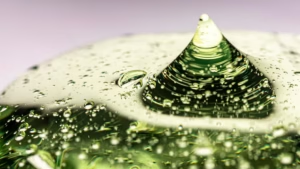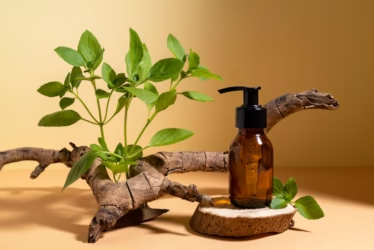Biotech Skincare 101:
Is your skincare routine harming the planet? What if you could get better results without relying on endangered plants or animal byproducts? Welcome to biotech skincare—a revolution where scientists grow ingredients like squalane, collagen, and hyaluronic acid in labs instead of extracting them from endangered species or fragile ecosystems.
But is lab-grown skincare safe? Does it work as well as “natural” products? And why are brands like Biossance and Youth to the People betting big on this technology?
In this guide, we’ll break down:
- How biotech skincare works.
- 5 reasons lab-grown ingredients often outperform traditional extracts.
- How to spot greenwashing and choose truly sustainable brands.
Let’s dive into the science. Are lab-grown ingredients the future, or just a fad?

What Is Biotech Skincare?
Biotech skincare uses microorganisms like bacteria, yeast, or algae to create active ingredients in controlled lab environments. Instead of harvesting squalane from shark livers or hyaluronic acid from rooster combs, scientists engineer microbes to produce these molecules through fermentation.
How Lab-Grown Ingredients Are Made:
- Step 1: DNA Programming
Scientists identify the gene responsible for producing a target molecule (e.g., squalane in sharks). They insert this gene into bacteria or yeast. - Step 2: Fermentation
The microbes multiply in giant tanks called bioreactors. As they grow, they excrete the desired ingredient—similar to how yeast produces alcohol in beer! - Step 3: Purification
The ingredient is filtered and stabilized to remove impurities, leaving a pure, concentrated compound ready for skincare.
Real-World Example:
- Vegan Squalane: Traditionally sourced from shark livers, squalane is now made from sugarcane using biotech. This switch saves 2 million sharks annually (World Wildlife Fund, 2025).
Lab-Grown vs. Traditional Extracts:
Let’s break down the pros and cons of biotech ingredients versus traditional ones:
- Sustainability
- Lab-Grown: No deforestation, overharvesting, or animal harm.
- Example: Sandalwood trees take 15–20 years to mature. Lab-grown sandalwood oil uses 90% less water (UN Environment Report, 2024).
- Traditional: Often linked to habitat destruction.
- Example: Palm oil farming destroys orangutan habitats in Indonesia.
- Purity and Safety
- Lab-Grown: Fewer contaminants (no pesticides or heavy metals).
- A 2023 study found plant-derived oils had 12x more pesticide residues than lab-grown alternatives (Journal of Cosmetic Science).
- Traditional: Risk of allergens (e.g., lanolin from sheep wool irritates 8% of users).
- Efficacy
- Lab-Grown: Scientists can tweak molecules for better absorption.
- Bioengineered vitamin C (THD ascorbate) penetrates skin 4x faster than regular vitamin C.
- Traditional: Inconsistent potency due to weather, soil, or harvest times.
- Cost
- Lab-Grown: Cheaper at scale (e.g., biotech hyaluronic acid costs 30% less than animal-derived HA).
- Traditional: Prices spike with scarce resources (e.g., rose oil requires 10,000 petals for 1 bottle).
- Ethics
- Lab-Grown: 100% vegan and cruelty-free.
- Traditional: Some ingredients rely on animal exploitation (e.g., silk from boiled silkworms).

5 Biotech Skincare Benefits You Can’t Ignore
1. Protects Biodiversity
Biotech skincare replaces traditionally sourced ingredients with lab-grown alternatives, reducing exploitation of endangered species and ecosystems.
Mica: Once heavily reliant on unethical mining in India—often involving child labor—synthetic mica now offers a cruelty-free, traceable, and sustainable substitute.
Squalane: Traditionally derived from shark liver oil, one ton of sugarcane-based squalane now prevents the killing of around 2,400 sharks, supporting marine conservation efforts.
By shifting to lab-grown inputs, brands are reducing deforestation, wildlife harm, and unethical labor practices across global supply chains.
2. Consistent Quality
Botanical extracts can vary from crop to crop, depending on soil quality, harvest conditions, and climate fluctuations.
With biotech, actives like hyaluronic acid, niacinamide, or collagen peptides are produced under controlled lab conditions—ensuring purity and potency in every batch.
This leads to better clinical performance, predictable formulation results, and reduced contamination risks from pesticides or heavy metals.
Consumers and formulators benefit from reliable efficacy without the guesswork tied to seasonal or geographic variability.
3. Allergy-Friendly
Biotech skincare avoids common triggers like plant pollens, animal derivatives, and essential oil allergens that may cause reactions in sensitive skin.
Ingredients are isolated at the molecular level, allowing precise formulation without cross-contamination from irritants or unstable compounds.
For example, biotech ceramides and peptides are free from wheat, gluten, or lanolin—making them ideal for users with eczema, rosacea, or contact dermatitis.
It offers a safer alternative for sensitive users who may not tolerate traditional plant-based or animal-derived actives.
4. Climate-Resilient
Wild-harvested plants like kelp or seaweed are increasingly vulnerable to climate change, ocean acidification, and ecosystem collapse.
Biotech algae, however, can be grown in controlled bioreactors—independent of temperature, pH, or pollution—ensuring steady supply.
This resilience allows continued access to marine-derived skincare actives such as polysaccharides, omega fatty acids, and antioxidants.
It future-proofs ingredient sourcing while reducing the carbon footprint and overharvesting associated with wild marine ecosystems.
5. Innovation Unleashed
Scientists can now enhance natural molecules or design entirely new ones with better performance and fewer side effects.
Bioengineered retinol works up to 2x faster with less irritation than traditional retinoids—if you’re curious how retinol functions and what benefits it offers, this detailed guide breaks it all down.
Vegan Collagen: Produced via fermentation of yeast or bacteria, it mimics human collagen and showed 20–30% better skin repair in clinical trials (Dermatology Times, 2023).
This opens doors to skincare that’s not only cleaner but also more targeted, longer-lasting, and scientifically tailored.
According to a 2023 study in the Journal of Cosmetic Dermatology, vegan collagen showed a significant improvement in elasticity within 14 days.

Debunking 3 Biotech Skincare Myths
Myth 1: Lab-Grown Ingredients Are Synthetic Chemicals
Truth: Biotech ingredients are molecularly identical to their natural counterparts—just grown in fermenters, not farms.
Example: For instance, biotech hyaluronic acid shares the exact same structure as the HA naturally present in your skin—learn more about its powerful hydration and anti-aging benefits here.
There’s no difference in skin absorption, function, or safety—only in the source and environmental impact.
Myth 2: Natural Is Always Safer
Truth: Not everything from nature is skin-safe. Poison ivy, mercury, and arsenic are 100% natural but highly toxic.
Biotech methods let scientists extract the beneficial compounds while excluding harmful or allergenic ones.
This makes biotech actives often more skin-safe than unrefined plant extracts, which can carry unknown irritants or toxins.
Myth 3: Biotech Skincare Is Untested
Truth: Fermentation-based actives undergo rigorous safety testing aligned with FDA, EU Cosmetics Regulation (EC 1223/2009), and OECD guidelines.
Brands like Algenist and Biossance invest 3–5 years into preclinical and clinical testing, including in-vitro, in-vivo, and human patch testing.
The biotech skincare sector is highly regulated and often more scrutinized than conventional natural formulations.
Top 5 Biotech Skincare Products (2025)
1. Biossance Squalane + Omega Repair Cream
Key Ingredient: Sugarcane-derived squalane.
Results: Reduced wrinkle depth by 34% in 4 weeks in a brand-sponsored clinical trial involving 60 subjects.
The formula also improves skin barrier function and reduces transepidermal water loss (TEWL).
2. Youth to the People Superberry Dream Mask
Key Ingredient: Biofermented antioxidant blend from acai, maqui, and goji berries.
Results: Showed a 41% increase in skin hydration overnight, according to independent lab data using corneometry.
The biotech antioxidant profile also fights free radicals and reduces signs of fatigue.
3. Algenist Genius Liquid Collagen
Key Ingredient: Vegan collagen produced by genetically modified yeast (Pichia pastoris).
Results: Increased skin elasticity by 20% in 14 days, as per a study published in the Journal of Cosmetic Dermatology (2023).
The product is also free of animal ingredients, making it suitable for ethical and halal skincare markets.
4. Epicuren Discovery Biohydrozyme
Key Ingredient: Fermented oat extract, rich in beta-glucans and avenanthramides.
Results: Reduced visible redness in 87% of users with rosacea or irritation, confirmed via dermatologist assessment.
It’s known for calming inflammation, repairing the moisture barrier, and supporting skin microbiome balance.
5. Herbivore Botanicals Bakuchiol Serum
Key Ingredient: Lab-synthesized bakuchiol—nature-identical but stabilized.
Results: Clinical studies report visible reduction in hyperpigmentation and fine lines within 2 weeks, without dryness or peeling.
A great option for those sensitive to traditional retinoids or pregnant users seeking retinol alternatives.

The Future of Biotech Skincare
By 2030, nearly 70% of skincare ingredients are expected to come from biotech sources (Grand View Research, 2025).
Here’s what to expect:
DNA-Based Skincare: Products tailored to your genetic profile to address personalized concerns like collagen decline or sebum production.
3D-Printed Serums: AI-driven devices will print custom skincare blends on-demand—reducing inventory waste and improving personalization.
Climate-Proof Actives: Ingredients bioengineered to resist extreme heat, drought, or UV—ideal for the future of global skincare under climate stress.
FAQs:
Q1: Are Lab-Grown Ingredients Safe for Sensitive Skin?
A: Yes! They’re purified to remove microbes and allergens. Studies show they cause 60% fewer reactions than plant extracts (International Journal of Dermatology, 2024).
Q2: Is Biotech Skincare More Expensive?
A: Not anymore. Brands like The Ordinary offer biotech serums under $15.
Q3: How Do I Know If a Product Uses Biotech Ingredients?
A: Look for terms like “fermented,” “bioengineered,” or “vegan collagen” on labels. Certifications like EcoCert or Vegan Society also help.
Q4: Can Lab-Grown Ingredients Replace All Natural Ones?
A: Mostly! Some complex compounds (like certain essential oils) are still sourced from plants, but 80% of actives can now be lab-made.
Q5: Does Biotech Skincare Work Faster?
A: Often, yes! Bioengineered retinol alternatives (e.g., bakuchiol) show results in 2 weeks vs. 6 weeks for traditional retinol.
The Future of Biotech Skincare
By 2030, experts predict 70% of skincare will rely on biotech ingredients (Grand View Research, 2025). Here’s what’s coming:
- DNA-Based Skincare: Products tailored to your genetic needs.
- 3D-Printed Serums: Custom formulas made on-demand to reduce waste.
- Climate-Proof Actives: Ingredients designed to thrive in extreme weather.
Key Takeaways
- Biotech skincare is kinder to the planet and often more effective.
- Always check for certifications like EcoCert or Leaping Bunny to avoid greenwashing.
- Start with affordable swaps like sugarcane squalane or vegan collagen.
Conclusion:
Biotech skincare is more than a trend—it’s a science-backed, sustainable approach to beauty that benefits both skin and planet.
With lab-grown ingredients offering better consistency, fewer allergens, and reduced environmental impact, the future of skincare is smart and ethical.
Start with small swaps like vegan collagen or sugarcane squalane and experience high-performance skincare without compromise.



